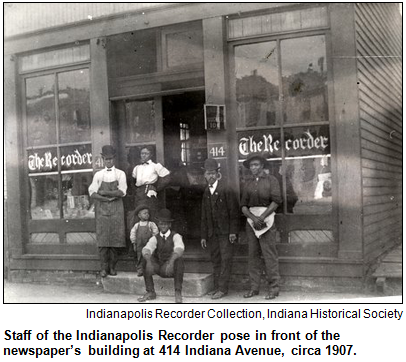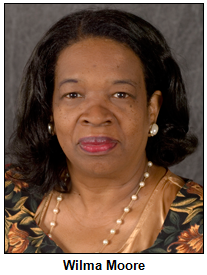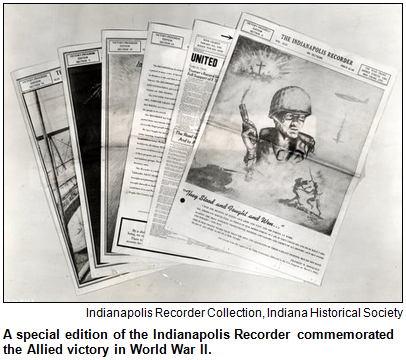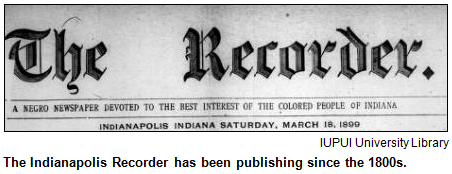You can listen to Hoosier History Live! live on the air each Saturday, or listen online at the WICR website during the broadcast on any computer with speakers, anywhere, or on a smartphone. We invite you to visit our website!
Feb. 11 show
African-American newspapers across Indiana
 They covered news, topics and public figures ignored or given short shrift by mainstream newspapers, including the triumphs of athletes such as bicyclist Major Taylor and baseball great Oscar Charleston.
They covered news, topics and public figures ignored or given short shrift by mainstream newspapers, including the triumphs of athletes such as bicyclist Major Taylor and baseball great Oscar Charleston.
Since the late 1800s, African-American newspapers have had an impact on communities across the Hoosier state. The most enduring has been the Indianapolis Recorder, which our guest Wilma Moore calls "the single most important tool for researching the history of African Americans in Indianapolis."
As Hoosier History Live! salutes Black History Month, Nelson will be joined in studio by Wilma, the senior archivist for African-American history at the Indiana Historical Society.
 In addition to delving into the history of the Recorder, a weekly newspaper that began in the 1890s, we will explore the Gary INFO in Lake County; the Evansville Argus, which was published from 1938 to 1943, and the Indianapolis Freeman, a competitor to the Recorder during the 1920s. The Freeman was heralded for increasing the popularity of Negro League Baseball because its sportswriters provided extensive coverage.
In addition to delving into the history of the Recorder, a weekly newspaper that began in the 1890s, we will explore the Gary INFO in Lake County; the Evansville Argus, which was published from 1938 to 1943, and the Indianapolis Freeman, a competitor to the Recorder during the 1920s. The Freeman was heralded for increasing the popularity of Negro League Baseball because its sportswriters provided extensive coverage.
Known for emphasizing local and statewide news, the Recorder covered topics ranging from the political power of the Ku Klux Klan in Indiana during the 1920s to the jazz scene that flourished along Indiana Avenue in Indianapolis after World War II.
Launched as a two-page church bulletin and business directory in 1897, the Recorder became a weekly two years later. At the turn of the last century, the Recorder reported the triumphs of Indy native Marshall "Major" Taylor, who became a world champion bicyclist.
And in 1901, according to Wilma's research, the Recorder published the names of black Indianapolis residents whose wealth was estimated at more than $5,000. The Recorder also listed African-Americans doing business in Indiana.
 In Evansville, several newspapers serving the black community were launched, with the first appearing in 1880. All of them lasted less than a year, though, until the Evansville Argus began in 1938. Crusading against segregation, the Argus supported efforts to integrate Mechanical Arts, a vocational high school in Evansville. The Argus also published stories about local and national accomplishments by African-Americans.
In Evansville, several newspapers serving the black community were launched, with the first appearing in 1880. All of them lasted less than a year, though, until the Evansville Argus began in 1938. Crusading against segregation, the Argus supported efforts to integrate Mechanical Arts, a vocational high school in Evansville. The Argus also published stories about local and national accomplishments by African-Americans.
So did the Indianapolis Freeman, which began in 1888.
Sportswriters at the Freeman were hailed for their in-depth coverage of Negro League Baseball, which, as we noted during a Hoosier History Live! show last summer, held their first official game in Indianapolis.
The Freeman extensively covered the triumphs of Indy native Oscar Charleston (1896-1954), a star in the Negro leagues who is considered to have been one of the greatest (albeit generally unheralded) players in baseball history.
In general, though, the Recorder offered much more extensive local coverage than the Freeman. That, according to the Encyclopedia of Indianapolis, was one of the factors in the demise of the Freeman in 1926.
Two newspapers also served the African-American community in Gary during more recent times. The Gary INFO stopped publishing in the late 1990s, according to Wilma's research. The Gary Crusader is affiliated with the Chicago Crusader; the publications even have shared some editors.
The Recorder, though, has the distinction of being the state's longest continually operated African-American newspaper.  The family of one of its co-founders, George Stewart, owned the newspaper until the late 1980s, when it was purchased by former Indianapolis Star editor Eunice Trotter. In 1990, the weekly was purchased by Indianapolis businessman Bill Mays.
The family of one of its co-founders, George Stewart, owned the newspaper until the late 1980s, when it was purchased by former Indianapolis Star editor Eunice Trotter. In 1990, the weekly was purchased by Indianapolis businessman Bill Mays.
Distinguished journalists who began their careers at the Recorder include Washington Post columnist William Raspberry, who is nationally syndicated.
Since the 1970s and '80s, the Recorder has provided extensive coverage of Indiana Black Expo and the Circle City Classic, two Indianapolis-based events that have drawn national attention.
"It is the single, most important publication that captures a panoramic view of 20th-century black Indianapolis,' Wilma has written of the Recorder.
The digital archives of the Recorder are available at IUPUI's University Library. The full-text, searchable archives include more than 5,000 issues of the newspaper. The Jim Crow History website is another source for information about black-owned newspapers in Indiana.
History Mystery
In the 1800s, Hamilton County was the site of an early settlement of African-Americans. They journeyed from North Carolina to a rural area near what became the town of Noblesville and established their settlement. In 1865, the black families built a chapel that remains on the site to this day. Reunions of descendants of the early settlers also continue to this day.
Question: Name the historic African-American settlement that was established in Hamilton County.
To win the prize, you must call in with the correct answer during the live show. Please do not call if you have won a prize from any WICR show during the last two months. The call-in number is (317) 788-3314, and please do not call until you hear Nelson pose the question on the air.
The prize is a gift certificate to the Jameson Inn on the west side of Indianapolis. This prize is courtesy of the ICVA.
 Roadtrip: Tales from the Super Bowl
Roadtrip: Tales from the Super Bowl
Roadtripper Chris Gahl, vice president of marketing and communications for the ICVA, returns to our airwaves this Saturday after a three-week hiatus, him having been at the epicenter of Indy's successful hosting of the Super Bowl.
We couldn't resist asking Chris if he would give us his own version of why Indianapolis made history last week.
Also, here's a locally produced time-lapsed video by Dusty Frey.
RSVP today!
Feb. 16 is our fourth-anniversary party
Can you believe it? Hoosier History Live! has been on the air for four years! We are proud to have become a unique asset to the state of Indiana, producing original content every week that is then added to our growing online archive. Thanks to all who have listened, clicked, browsed and supported the show!
 We plan to be around quite awhile longer, contributing to Indiana's culture and offering a well-reported take on our state's rich and varied history.
We plan to be around quite awhile longer, contributing to Indiana's culture and offering a well-reported take on our state's rich and varied history.
Come join in the festivities as we celebrate four years on the air at the Morris-Butler House, 1204 N. Park Ave. in Indianapolis, on Thursday, Feb. 16 from 5 to 8 p.m.
Wine, soft drinks and appetizers will be served. Generously hosted by Indiana Landmarks. This is a free event. For those who choose, checks of support (payable to Indiana Humanities, with a memo line "for Hoosier History Live!") are graciously accepted but certainly not expected.
You can click here to RSVP, or send an email to molly@hoosierhistorylive.org.
Your Hoosier History Live! team,
Nelson Price, host and creative director
Molly Head, producer, (317) 927-9101
Chris Gahl, Roadtripper
Richard Sullivan, webmaster and tech director
Pam Fraizer, graphic designer
Garry Chilluffo, creative consultant
Michele Goodrich, Jed Duvall, grant consultants
Joan Hostetler, photo historian
Dana Waddell, volunteer-at-large
www.hoosierhistorylive.org





Please tell our sponsors that you appreciate their support: Aesop's Tables, Indiana Historical Society, Indiana Landmarks, Lucas Oil and Story Inn.
 Acknowledgments to Print Resources, Indianapolis Marion County Public Library, Monomedia, Indiana Humanities, Indianapolis Convention & Visitors Association, WICR-FM, Fraizer Designs, Heritage Photo and Research Services, Derrick Lowhorn, Samantha Stratton and many other individuals and organizations. We are an independently produced program and are self-supporting through organizational sponsorships, grants and through individual tax-deductible contributions through the Indiana Humanities Council. Visit our website to learn how you can support us financially.
Acknowledgments to Print Resources, Indianapolis Marion County Public Library, Monomedia, Indiana Humanities, Indianapolis Convention & Visitors Association, WICR-FM, Fraizer Designs, Heritage Photo and Research Services, Derrick Lowhorn, Samantha Stratton and many other individuals and organizations. We are an independently produced program and are self-supporting through organizational sponsorships, grants and through individual tax-deductible contributions through the Indiana Humanities Council. Visit our website to learn how you can support us financially.
Feb. 18 show
Snow history with weatherman Chris Wright
 Even though WTHR-TV/Channel 13 meteorologist Chris Wright is known for his sunny disposition, he loves snow. He frequently mentions his fondness during the evening newscasts of the NBC affiliate in Indianapolis. So who better to be our guide as we journey - or trudge - through snowfall history in the Hoosier state?
Even though WTHR-TV/Channel 13 meteorologist Chris Wright is known for his sunny disposition, he loves snow. He frequently mentions his fondness during the evening newscasts of the NBC affiliate in Indianapolis. So who better to be our guide as we journey - or trudge - through snowfall history in the Hoosier state?
Chris, who has been an amiable on-camera presence at WTHR since 1999, will join Nelson in studio to cover the waterfront, snow-wise. We will explore Indiana winters with the most white stuff and those with the least, as well as the dreaded "lake effect" that affects South Bend and other northern Indiana communities.
Of course, our current winter is far from history at this point. But we can explore the snowfall pattern so far. According to a recent Indianapolis Star story that relied on National Weather Service data, the snowiest January in Indy city history was January 1978. That reflects the notorious Blizzard of '78, generally considered the worst blizzard in city history.
 Incidentally, the blizzard's 30th anniversary was the topic of the second Hoosier History Live! show on Jan. 19, 2008. You can listen to a clip from Nelson's interview that day with guest Craig Widener, who was with the Red Cross and helped hundreds of stranded bus passengers in downtown Indianapolis.
Incidentally, the blizzard's 30th anniversary was the topic of the second Hoosier History Live! show on Jan. 19, 2008. You can listen to a clip from Nelson's interview that day with guest Craig Widener, who was with the Red Cross and helped hundreds of stranded bus passengers in downtown Indianapolis.
At the other extreme, the most snow-free January in city history occurred in 1937, when nary a flake fell from the sky. Indy's average snowfall in January is 8.6 inches, meaning last month's 4.4 inches was about half the January average.
As we prepare to dig for more snow history from Chris Wright, we can't resist pointing out the multifaceted talents of our guest. In addition to anchoring Channel 13's "Sky Trak Weather," he hosts The Brain Game, the long-running quiz show featuring Hoosier high school students.
Chris also is the author of nine mystery novels, including Rockabye Baby (2001), which focused on a kidnapping aboard an airplane of a prominent attorney's infant daughter.
Before joining WTHR, Chris was the meteorologist for WISH-TV/Channel 8 in Indianapolis. In 1994, he was named the National Weather Association Broadcaster of the Year.
Chris recommends these "learn more" websites:
© 2012 Hoosier History Live! All rights reserved.